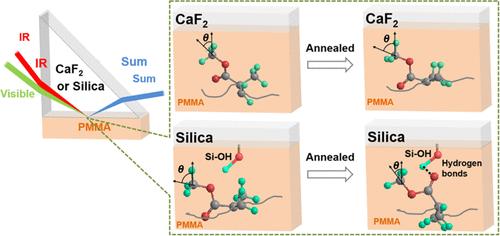Our official English website, www.x-mol.net, welcomes your
feedback! (Note: you will need to create a separate account there.)
Molecular Structures of Poly(methyl methacrylate) at Different Buried Interfaces Revealed by Sum Frequency Generation Vibrational Spectroscopy
Langmuir ( IF 3.7 ) Pub Date : 2024-09-24 , DOI: 10.1021/acs.langmuir.4c03038 Xintong Hu, Bolin Li, Zhaohui Xu, Yong-Hao Ma, Xiaofeng Han, Linhua Hu, Chu Wang, Ningfang Wang, Jinsheng Xu, Zhigao Sheng, Xiaolin Lu
Langmuir ( IF 3.7 ) Pub Date : 2024-09-24 , DOI: 10.1021/acs.langmuir.4c03038 Xintong Hu, Bolin Li, Zhaohui Xu, Yong-Hao Ma, Xiaofeng Han, Linhua Hu, Chu Wang, Ningfang Wang, Jinsheng Xu, Zhigao Sheng, Xiaolin Lu

|
Silica or calcium fluoride (CaF2) substrate-supported poly(methyl methacrylate) (PMMA) thin films as insulating layers are commonly used in photoelectric/photovoltaic devices to improve the efficiency or stability of these devices. However, a comparative investigation of molecular structures at buried PMMA/silica and PMMA/CaF2 interfaces under thermal stimuli remains unexplored. In this study, we qualitatively and quantitatively revealed different molecular orderings and orientations of PMMA at two interfaces before and after annealing using sum frequency generation (SFG) vibrational spectroscopy. SFG vibrations were carefully assigned by using various deuterated PMMAs. SFG results indicated that, at the buried PMMA/silica interface, the side OCH3 groups were prone to lie down before annealing and tended to stand up after annealing. In contrast, the case was the opposite at the buried PMMA/CaF2 interface. The relative hydrophobicity/hydrophilicity of the two substrates and the developed hydrogen bonds upon annealing at the buried PMMA/silica interface, which is absent at the CaF2 surface, are believed to be the driving forces for different interfacial molecular structures. This study benefits the molecular-level understanding of the interfacial local structural relaxation of polymers at buried interfaces and the rational design of photoelectric/photovoltaic devices from the molecular level.
中文翻译:

和频振动光谱揭示聚甲基丙烯酸甲酯不同埋入界面的分子结构
二氧化硅或氟化钙(CaF 2 )基板支撑的聚甲基丙烯酸甲酯(PMMA)薄膜作为绝缘层通常用于光电/光伏器件中以提高这些器件的效率或稳定性。然而,热刺激下埋入式PMMA/二氧化硅和PMMA/CaF 2界面的分子结构的比较研究尚未探索。在这项研究中,我们使用和频发生(SFG)振动光谱定性和定量地揭示了退火前后两个界面处 PMMA 的不同分子排序和取向。通过使用各种氘代 PMMA 仔细分配 SFG 振动。 SFG结果表明,在埋入式PMMA/二氧化硅界面处,侧向OCH 3基团在退火前倾向于躺下,而在退火后倾向于竖起。相反,埋入PMMA/CaF 2界面处的情况相反。两种基材的相对疏水性/亲水性以及退火时在埋入式PMMA/二氧化硅界面处形成的氢键(CaF 2表面不存在)被认为是不同界面分子结构的驱动力。该研究有利于从分子水平理解聚合物在埋入界面处的界面局部结构弛豫以及从分子水平合理设计光电/光伏器件。
更新日期:2024-09-25
中文翻译:

和频振动光谱揭示聚甲基丙烯酸甲酯不同埋入界面的分子结构
二氧化硅或氟化钙(CaF 2 )基板支撑的聚甲基丙烯酸甲酯(PMMA)薄膜作为绝缘层通常用于光电/光伏器件中以提高这些器件的效率或稳定性。然而,热刺激下埋入式PMMA/二氧化硅和PMMA/CaF 2界面的分子结构的比较研究尚未探索。在这项研究中,我们使用和频发生(SFG)振动光谱定性和定量地揭示了退火前后两个界面处 PMMA 的不同分子排序和取向。通过使用各种氘代 PMMA 仔细分配 SFG 振动。 SFG结果表明,在埋入式PMMA/二氧化硅界面处,侧向OCH 3基团在退火前倾向于躺下,而在退火后倾向于竖起。相反,埋入PMMA/CaF 2界面处的情况相反。两种基材的相对疏水性/亲水性以及退火时在埋入式PMMA/二氧化硅界面处形成的氢键(CaF 2表面不存在)被认为是不同界面分子结构的驱动力。该研究有利于从分子水平理解聚合物在埋入界面处的界面局部结构弛豫以及从分子水平合理设计光电/光伏器件。











































 京公网安备 11010802027423号
京公网安备 11010802027423号